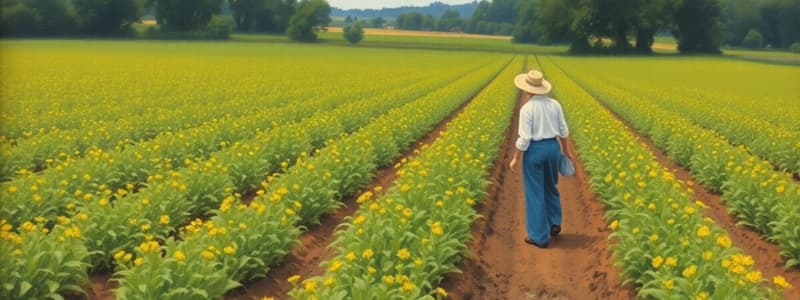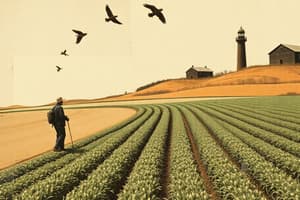Podcast
Questions and Answers
What is agriculture primarily concerned with?
What is agriculture primarily concerned with?
- The study of ancient civilizations
- The cultivation of plants and livestock (correct)
- The exploration of outer space
- The development of computer software
Which of the following is an example of a common agricultural practice?
Which of the following is an example of a common agricultural practice?
- Developing new medical treatments
- Mining for precious metals
- Building skyscrapers
- Planting crops (correct)
What does 'crop production' refer to?
What does 'crop production' refer to?
- The process of manufacturing goods in factories
- The creation of artistic masterpieces
- The growing of plants for harvest (correct)
- The study of climate patterns
Which of the following is a crucial input for crop production?
Which of the following is a crucial input for crop production?
What is the purpose of irrigation in crop production?
What is the purpose of irrigation in crop production?
Flashcards
What is agriculture?
What is agriculture?
The process of growing plants or raising animals for food, fiber, and other products.
What is crop production?
What is crop production?
The science and practice of growing crops.
What is irrigation?
What is irrigation?
The process of supplying water to land or crops to help growth.
What are fertilizers?
What are fertilizers?
Signup and view all the flashcards
What are soil microbes?
What are soil microbes?
Signup and view all the flashcards
Study Notes
Crop Production
- Crop production involves various practices aimed at cultivating plants for human use, encompassing food, feed, fiber, and other products.
- Understanding the principles of crop production is essential for maximizing yields and ensuring food security.
- This includes preparing the land, selecting appropriate seeds, managing nutrients and water, controlling pests and diseases, and harvesting and storing the produce.
Soil Preparation
- Soil preparation is the first and a crucial step in crop production.
- It involves tilling or plowing the soil to create a suitable seedbed.
- Adequate soil preparation ensures proper aeration, water infiltration, and root penetration.
- Methods may include plowing, harrowing, leveling, and manuring.
Seed Selection
- Selecting high-quality seeds is vital for a successful crop.
- Seeds should be disease-free, viable, and suited to the local climate and soil conditions.
- Farmers may choose from various types of seeds, including hybrid seeds, genetically modified seeds, or open-pollinated varieties.
- Seed treatment with fungicides or insecticides may be necessary to protect against early-season pests and diseases.
Sowing
- Sowing is the process of planting seeds in the prepared soil.
- Methods of sowing vary depending on the crop, soil type, and available resources.
- Common methods include broadcasting, drilling, dibbling, and transplanting.
- Proper sowing depth and spacing are important to ensure optimal germination and plant growth.
Irrigation
- Irrigation is the artificial application of water to the soil to supplement rainfall and meet the water requirements of crops.
- Different irrigation methods are available, including surface irrigation, sprinkler irrigation, drip irrigation, and subsurface irrigation.
- The choice of irrigation method depends on factors such as water availability, soil type, crop type, and cost.
- Efficient irrigation practices are essential for conserving water resources and maximizing crop yields.
Nutrient Management
- Nutrient management involves providing crops with the essential nutrients they need for growth and development.
- Plants require macronutrients such as nitrogen, phosphorus, and potassium, as well as micronutrients such as iron, zinc, and manganese.
- Nutrients can be supplied through organic manures, chemical fertilizers, or a combination of both.
- Soil testing is important to determine the nutrient status of the soil and guide fertilizer application.
Weed Control
- Weeds compete with crops for water, nutrients, and sunlight, reducing crop yields.
- Weed control is essential for maximizing crop production.
- Weed control methods include manual weeding, mechanical weeding, chemical weeding (using herbicides), and biological control.
- Integrated weed management strategies that combine different methods are often the most effective.
Pest and Disease Management
- Pests and diseases can cause significant damage to crops, leading to yield losses.
- Pest and disease management involves identifying and controlling pests and diseases using various methods.
- These methods include cultural practices, biological control, chemical control (using pesticides), and integrated pest management.
- Integrated pest management (IPM) is a holistic approach that combines different strategies to minimize pesticide use and environmental impact.
Harvesting
- Harvesting is the process of gathering the mature crop from the field.
- The timing of harvest is crucial to ensure optimal yield and quality.
- Harvesting methods vary depending on the crop and available resources.
- Manual harvesting is common for many crops, while mechanized harvesting is used for large-scale production.
Storage
- Proper storage is essential for preventing post-harvest losses due to spoilage, pests, and diseases.
- Storage facilities should be clean, dry, and well-ventilated.
- Different storage methods are available, including traditional methods such as grain bins and modern methods such as cold storage and controlled atmosphere storage.
- Proper storage practices help maintain the quality and nutritional value of the harvested crop.
Crop Rotation
- Crop rotation is the practice of growing different crops in a planned sequence on the same piece of land.
- Crop rotation helps improve soil health, reduce pest and disease problems, and increase crop yields.
- Different crop rotations are suited to different regions and farming systems.
- Legumes are often included in crop rotations to fix nitrogen in the soil.
Sustainable Agriculture
- Sustainable agriculture aims to produce food and fiber in a way that is environmentally sound, economically viable, and socially responsible.
- Sustainable agriculture practices include crop rotation, conservation tillage, integrated pest management, and organic farming.
- Sustainable agriculture helps protect natural resources, reduce pollution, and enhance biodiversity.
Precision Farming
- Precision farming uses technology to optimize crop production by tailoring management practices to specific field conditions.
- Precision farming technologies include GPS, remote sensing, GIS, and variable rate applicators.
- Precision farming can help reduce input costs, increase yields, and minimize environmental impact.
Studying That Suits You
Use AI to generate personalized quizzes and flashcards to suit your learning preferences.




